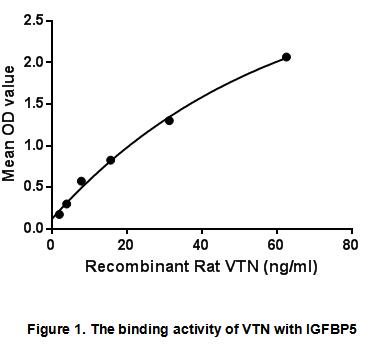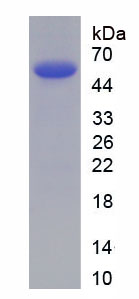Active Vitronectin (VTN)
V75; VN; VNT; Serum Spreading Factor; Somatomedin B; Complement S-Protein
- Product No.APB041Ra01
- Organism SpeciesRattus norvegicus (Rat) Same name, Different species.
- Buffer FormulationPBS, pH7.4, containing 0.01% SKL, 5% Trehalose.
- Traits Freeze-dried powder
- Purity> 90%
- Isoelectric Point6.3
- ApplicationsCell culture; Activity Assays.
- DownloadInstruction Manual
- UOM 10µg50µg 200µg 1mg 5mg
- FOB
US$ 331
US$ 828
US$ 1656
US$ 4968
US$ 12420
For more details, please contact local distributors!
ACTIVITY TEST

Vitronectin (VTN ) is a glycoprotein of the hemopexin family which is abundantly found in serum, the extracellular matrix and bone. It is a secreted protein and exists in either a single chain form or a clipped, two chain form held together by a disulfide bond. VTN can binds to integrin alpha-V beta-3 and thus promotes cell adhesion and spreading. It also binds to plasminogen activator inhibitor-1 (PAI-1) and serves to regulate proteolysis initiated by plasminogen activation. Besides, Insulin Like Growth Factor Binding Protein 5 (IGFBP5) has been identified as an interactor of VTN, thus a binding ELISA assay was conducted to detect the interaction of recombinant Rat VTN and recombinant Rat IGFBP5. Briefly, VTN were diluted serially in PBS, with 0.01% BSA (pH 7.4). Duplicate samples of 100ul were then transferred to IGFBP5-coated microtiter wells and incubated for 2h at 37℃. Wells were washed with PBST and incubated for 1h with anti-VTN pAb, then aspirated and washed 3 times. After incubation with HRP labelled secondary antibody, wells were aspirated and washed 3 times. With the addition of substrate solution , wells were incubated 15-25 minutes at 37℃. Finally, add 50µL stop solution to the wells and read at 450nm immediately. The binding activity of VTN and IGFBP5 was shown in Figure 1, and this effect was in a dose dependent manner.
USAGE
Reconstitute in 10mM PBS (pH7.4) to a concentration of 0.1-1.0 mg/mL. Do not vortex.
STORAGE
Avoid repeated freeze/thaw cycles. Store at 2-8°C for one month. Aliquot and store at -80°C for 12 months.
STABILITY
The thermal stability is described by the loss rate. The loss rate was determined by accelerated thermal degradation test, that is, incubate the protein at 37°C for 48h, and no obvious degradation and precipitation were observed. The loss rate is less than 5% within the expiration date under appropriate storage condition.
GIVEAWAYS
INCREMENT SERVICES
-
 BCA Protein Quantification Kit
BCA Protein Quantification Kit
-
 Molecular Mass Marker for Protein
Molecular Mass Marker for Protein
-
 Monoclonal Antibody Customized Service
Monoclonal Antibody Customized Service
-
 Polyclonal Antibody Customized Service
Polyclonal Antibody Customized Service
-
 Protein Activity Test Experiment Service
Protein Activity Test Experiment Service
-
 Electrophoretic Mobility Shift Assay (EMSA) Experiment Service
Electrophoretic Mobility Shift Assay (EMSA) Experiment Service
-
 Buffer
Buffer
-
 Lentivirus Packaging Experiment Service
Lentivirus Packaging Experiment Service
-
 Adenovirus Packaging Experiment Service
Adenovirus Packaging Experiment Service
-
 Real Time PCR Experimental Service
Real Time PCR Experimental Service
-
 Spike RBD Protein (S-RBD)
Spike RBD Protein (S-RBD)
-
 Protein G
Protein G
-
 Protein A
Protein A
| Magazine | Citations |
| Biomedical Engineering and Informatics | Application of iTRAQ quantitative proteomics in identification of serum biomarkers in breast cancer IEEE: 6098563 |
| PLoS ONE | Identification of Altered Plasma Proteins by Proteomic Study in Valvular Heart Diseases and the Potential Clinical Significance PubMed: PMC3754973 |
| Liver International | Identification of candidate biomarkers for hepatocellular carcinoma in plasma of HCV-infected cirrhotic patients by 2-D DIGE Pubmed: 23944848 |
| Analytical Biochemistry | A multianalytical approach to investigate the effect of nanofiltration on plasma-derived factor IX clinical lots Pubmed:29154788 |
| Journal of Materials Chemistry B | Serum protein adsorption profile on BCP ceramic and influence of the elevated adsorption of adhesive proteins on the behaviour of MSCs Doi: 10.1039/C8TB02283F |
| JOURNAL OF NEPHROLOGY | Urinary vitronectin identifies patients with high levels of fibrosis in kidney grafts 33275196 |
| Catalog No. | Related products for research use of Rattus norvegicus (Rat) Organism species | Applications (RESEARCH USE ONLY!) |
| RPB041Ra01 | Recombinant Vitronectin (VTN) | Positive Control; Immunogen; SDS-PAGE; WB. |
| APB041Ra01 | Active Vitronectin (VTN) | Cell culture; Activity Assays. |
| PAB041Ra01 | Polyclonal Antibody to Vitronectin (VTN) | WB; IHC; ICC; IP. |
| MAB041Ra21 | Monoclonal Antibody to Vitronectin (VTN) | WB; IHC; ICC; IP. |
| SEB041Ra | ELISA Kit for Vitronectin (VTN) | Enzyme-linked immunosorbent assay for Antigen Detection. |
| LMB041Ra | Multiplex Assay Kit for Vitronectin (VTN) ,etc. by FLIA (Flow Luminescence Immunoassay) | FLIA Kit for Antigen Detection. |
| KSB041Ra01 | ELISA Kit DIY Materials for Vitronectin (VTN) | Main materials for "Do It (ELISA Kit) Yourself". |







